
Herdmania is a genus of ascidian tunicates in the family Pyuridae.

Addison Emery Verrill was an American invertebrate zoologist, museum curator and university professor.

Actiniidae is the largest family of sea anemones, to which most common, temperate, shore species belong. Most members of this family do not participate in symbioses with fishes. Three exceptions are the bubble-tip anemone, snakelocks anemone and Urticina piscivora.

Edwardsia is a genus of sea anemones, the type of the family Edwardsiidae. They have eight mesenteries and live in tubes in the sand. The name, in Neo-Latin, commemorates the French zoologist Henri Milne-Edwards.

Phlebobranchia is an order of sea squirts in the class Ascidiacea, first described by Fernando Lahille in 1886.

Halocynthia is a genus of ascidian tunicates in the family Pyuridae. Species such as H. roretzi are eaten in parts of Asia as a delicacy.

Dendronotidae is a family of sea slugs, nudibranchs, marine gastropod mollusks in the superfamily Dendronotoidea. This family is within the clade Cladobranchia.

Cadlina is a genus of sea slugs, dorid nudibranchs, shell-less marine gastropod mollusks historically classified in the family Chromodorididae. Recent research by R.F. Johnson in 2011 has shown that Cadlina does not belong to the family Chromodorididae. She has therefore brought back the name Cadlinidae from synonymy with Chromodorididae. The family Cadlinidae also includes the genus AldisaBergh, 1878.

Stolidobranchia is an order of tunicates in the class Ascidiacea. The group includes both colonial and solitary animals. They are distinguished from other tunicates by the presence of folded pharyngeal baskets. This provides the etymology of their name: in ancient Greek, στολίς, ίδος means the "fold" of a cloth. Stolidobranchian sea squirts are also characterized by the complete absence of an abdomen. The abdominal organs of other tunicates are instead located to one side of the pharyngeal basket in this group.
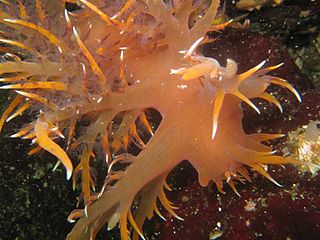
Dendronotus is a genus of sea slugs, nudibranchs, marine gastropod molluscs in the superfamily Tritonioidea.

Onchidoris is a genus of dorid nudibranchs in the family Onchidorididae. One of its members is known to prey on barnacles and the others eat bryozoans. The radula contains a rachidian tooth when fully developed, but this is vestigial in some species.
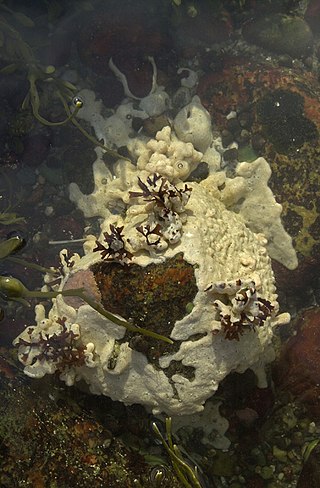
Aplousobranchia is an order of sea squirts in the class Ascidiacea, first described by Fernando Lahille in 1886. They are colonial animals, and are distinguished from other sea squirts by the presence of relatively simple pharyngeal baskets. This provides the etymology of their name: in ancient greek, ἁ.πλοος-ους (ha.ploos-ous) means "simple". The posterior part of the abdomen contains the heart and gonads, and is typically larger than in other sea squirts.

Urticina is a genus of relatively large and often colorful sea anemones in the family Actiniidae from the North Pacific, North Atlantic and Arctic Oceans.

Ceriantheopsis is a genus of tube-dwelling anemones in the family Cerianthidae. Members of the genus are found only in the Atlantic Ocean. They are predators, scavengers and omnivores.
Bostrichobranchus is a genus of ascidian tunicates in the family Molgulidae.
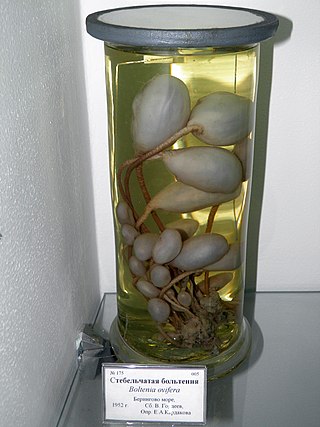
Boltenia is a genus of ascidian tunicates in the family Pyuridae.
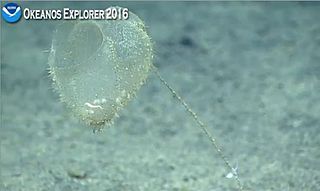
Culeolus is a genus of ascidian tunicates in the family Pyuridae.

Exaiptasia is a genus of sea anemone in the family Aiptasiidae, native to shallow waters in the temperate western Atlantic Ocean, the Caribbean Sea and the Gulf of Mexico. It is monotypic with a single species, Exaiptasia diaphana, and commonly known as the brown anemone, glass anemone, pale anemone, or simply as Aiptasia.

Mesacmaea is a genus of sea anemone in the family Haloclavidae. Members of this genus typically burrow into soft substrates. The only part of the animal that is normally visible is the oral disc and tentacles which lie flat on the sand in a star shape.
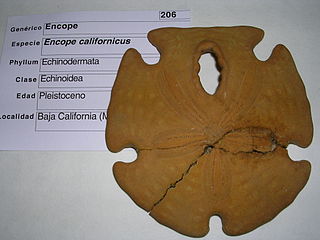
Encope is a genus of echinoderms belonging to the family Mellitidae.



















